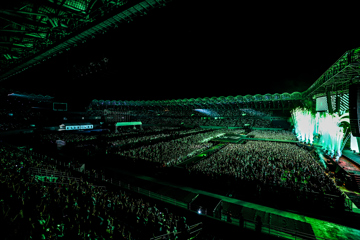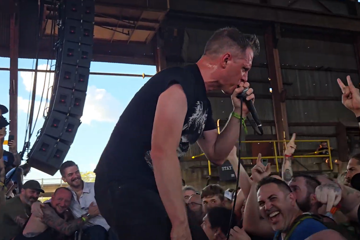Mariusz Lewandowski: the man behind the art

"I am attracted to the unknown: austere landscapes of distant worlds with looming artefacts as if from a nightmare."

You might not recognise Mariusz Lewandowski's name off the top of your head, but good chances are you've seen his handy work before across the metal spectrum.
As a younger man, bands like Black Sabbath, Led Zeppelin, and Deep Purple helped shape Mariusz Lewandowski's musical tastes, as did other electronic styles from the likes of Klaus Schulze, Jean-Michel Jarre, and Vangelis. The now 59-year-old Polish-born painter would also find an appreciation for progressive rock, like early Genesis, Pink Floyd, and Transatlantic, with some of his favourites being Yes, Dream Theater, Tangerine Dream, among others. Music has always been a passion of his, but also a vessel for the inspirations that guide his brush strokes.
Don't miss a beat with our FREE daily newsletter
"I love music that is very extensive, original, and without any boundaries to styles; one that takes my breath away and brings me to the world I am looking for in my paintings" Mariusz informs me. A mindset that clearly informs his approach to his own art: boundless and imaginative.
"If we are talking about heavy metal, he rather found me using Bell Witch, who asked me if I would make them a graphic for their latest album [2017's acclaimed 'Mirror Reaper'.] I was excited! I had never painted for musicians before [at the time]. It was a distinction for me, but also a great challenge that I undertook. So I created a picture for Mirror Reaper. Musically, it's a great album. I come back to it from time to time and still have goosebumps; I really feel the chemistry between this music and the motif that adorns the cover."
He continues. "As it turned out later, the music industry also appreciated this album. Once more, I began to learn about this style, and there were proposals from other teams: Psycroptic, Eremit, False and several more."
[caption id="attachment_1106763" align="aligncenter" width="750"] "Mirror Reaper".[/caption]
"Mirror Reaper".[/caption]
For many people, myself included, Bell Witch's 2017 LP was the very first time that I'd laid eyes upon Mariusz's work, and like so many others, it's cover just utterly captivated me. (There's also some irony here; whilst writing and editing this piece, I had 'Mirror Reaper' playing in the background. It just seemed... fitting.) There is a real tangible love for the nightmarish artwork Mariusz puts into the world, from not just fans and bands that wish to use his creative visions, but for the metal community as a whole. In fact, 2018 was a big year for him, seeing his art don many album covers.
While there's a passion for his art, and a reciprocated love to see his pieces used for album covers - like doom-metal sludgers Shrine of the Serpent ('Entropic Disillusion', 2018), thrash-metallers Sepulcher ('Panoptic Horror', 2018), death metal outfit Rogga Johansson ('Entrance to the Otherwhere'), and Cardiac Rupture's new album this month, like any other business, there's a process. And how exactly does that process work for Mariusz these days?
"Bands can contact me directly, reach me via Facebook, my website or my email. In the case of Bell Witch and Psycroptic, I created paintings for a specific order. When I'm doing something for a particular band, it's best when there is a thread of a telepathic channel that we communicate with no unnecessary words. I think that people are the most important, because they make this wonderful music and I'm glad that I can dress them in colours. As you can see, it works because usually albums and their artworks gather flattering opinions. I enjoy it, and it gives me more power to create even more interesting and inspiring themes."
"In the case of Rogga, Shrine of the Serpent and many others, they chose paintings from my extensive gallery; they have already used an already exist painting which I painted. In this case, if the conditions of use are accepted by both sides, the project can be finalised, and it is a convenient solution for both sides."
[caption id="attachment_1106765" align="aligncenter" width="760"] "Before It's Too Late" (Psycroptic's 2018 LP, 'As The Kingdom Drowns'.)[/caption]
"Before It's Too Late" (Psycroptic's 2018 LP, 'As The Kingdom Drowns'.)[/caption]
Mariusz kindly goes into more detail about he runs his business and how his art is used for releases, the licensing involved and all that jazz.
"When I create a commission for a band, we pre-arrange a license to use this image. So I sell the theme in digital form - the band can use it on many surfaces, in addition to the CD cover or vinyl and can print posters, flyers, t-shirts, gadgets, etc. The original painting stays with me, but the band takes precedence if they want to buy it."
"For example, the original painting for Bell Witch, that was sold to their publisher. The paintings for Psycroptic were also sold to them together with a license to use the painting. Buying the original is an additional cost for the band, but as you can see for people from these bands, these original paintings have a unique value and they want to have them in physical form, not only in digital form."
[caption id="attachment_1106766" align="aligncenter" width="500"] "Whispers of an Old Forest" (used for Shrine Of The Serpent's 'Entropic Disillusion'.)[/caption]
"Whispers of an Old Forest" (used for Shrine Of The Serpent's 'Entropic Disillusion'.)[/caption]
Mariusz's title in heavy metal continues to grow over time, something that he's become well-aware of himself over the last couple years. Mentioning that Bell Witch was a real springboard for him, thrusting his work and art deeper into the world of metal. This drives him.
"There are more and more inquiries about my art, and the bands ask if I could create art for them. In addition, more and more people mention my name in various articles, threads, and discussions related to the music industry - it motivates me very much!"
While we know he enjoys metal and paints for such artists, metal isn't the the sole genre that becomes his background score whilst painting. In fact, it's nothing resembling metal at all that accompany the artist's canvas journey's
"Metal should be listened to loudly, but to the process of painting, this music is too tiring for me, as I must have peace and such music is not able to give me that peace. During the painting process, electronic music comes to the fore, which I do not have to listen to loudly. This music moves other areas of the imagination in my head. I do not know if I'm not blaspheming here by juxtaposing such different musical genres, but most importantly, it works."
This flowing mood is often set during his own time of tranquillity, seeing the artist actually work during the night hours, allowing him the time and space to immerse himself in whatever the client wishes. He explains.
"I paint only at night because I need to have peace and confidence that no one will disturb me. When creating graphics for metal music, I must saturate my mind with the music that has been entrusted to me. But it's not only the music that the band will provide; the conversation, philosophy and assumptions of the music are also important. All of which makes my mind open and let me create something that will correlate with the music and not be a separate creation."
[caption id="attachment_1106767" align="aligncenter" width="683"] "Angel Of Death."[/caption]
"Angel Of Death."[/caption]
Nearly all of Mariusz's artworks are quite surrealist, fantastical and horror-based. It's his calling card, in a way. Yet he states that this may confuse people who enjoy his work but who also do not know him personally. As his constant use of "dark characters, omnipresent deaths, ruins and conflagration" don't actually reflect his world view.
"I actually really love life! I am not a bitter man who is waiting for the trumpets of angelic prophets of the apocalypse", he enthuses.
"I am referring to the message that death is an inseparable part of life. I know that there are many people who think like me, because where would the fascination with my paintings on such a scale come from? I think that there is also an element of getting rid of all the negative things that have been inculcated to us all over the millennia, so it is very difficult for people to throw off the ballast that limits us. I do not want to tell people how to live and what to believe, I just want them not to give up their thinking to others."
"For instance, you noticed that I use religious symbols in paintings, but it does not mean that I identify with them. It only shows how it corners us and makes life difficult," he thoughtfully explains.
[caption id="attachment_1106769" align="aligncenter" width="741"] "Atomic Emptiness."[/caption]
"Atomic Emptiness."[/caption]
Pouring over the oil paintings that Mariusz has brought to life, it's clear he loves to pull from apocalypses and cosmic horror; focusing in on barren worlds, cataclysms, and other-worldly beings that are completely beyond mere mortal comprehension. Again, it's that spectre of death that looms over life. In nearly every piece he creates, a lone figure can be found in the lower half of the paintings; a puny, lonesome human bearing witness to some horrific entity, a towering monolith, or a catastrophic event, unable to do anything but watch on.
He also places a strong focus on imagery pertaining to hooded, grim reaper-figures in many of his works too. Some might say that a Polish person loving such images and motifs is pretty much expected, but there is a reason behind all of this. For as the artist himself says, it's actually a simple one.
"I am attracted to the unknown: austere landscapes of distant worlds with looming artefacts as if from a nightmare. I would like to be well understood: I am not a frustrator longing for death, I tame her with me. I am not intimidated. Someone once said that in my paintings, despite their darkness, there is a lot of optimism and hope."
And what of those recurring reapers?
"Well, it's just a symbol, a shortcut. In fact, it is a positive figure: free from suffering and a new born on the ruins."
[caption id="attachment_1106773" align="aligncenter" width="480"] There's a lot more where these four pieces came from.[/caption]
There's a lot more where these four pieces came from.[/caption]
Painting isn't just a life-long passion of Mariusz but it's also his main profession - it's become his livelihood. It's something that drives and fulfils him. And as he said before, the grim images he creates do not reflect that of a jaded man tired and bitter with. Yet there's another "artwork" yet to be made in his personal life, something far more lush, homey, and simple.
"Painting is my passion and profession that we keep together with my beloved wife, who also works, but it is a job of a completely different nature - office work, completely two different worlds. My next passion is a piece of land in a village where we will build a dream home; a place surrounded by nature in which I love to stay, where I will finally have a real workshop and countless numbers of trees, birds, wild animals, fish and a lots of beautifully singing frogs. This is a place where I spend every spare moment."
[caption id="attachment_1106770" align="aligncenter" width="601"] "The Last Pilgrim."[/caption]
"The Last Pilgrim."[/caption]
While each piece has it's struggles and varying lengths of time to complete, there is always a personal satisfaction and enjoyment being held by the very man who holds the brush. But if that feeling of reward is not there, then what's the point? As Mariusz mentions to me: "It's best to paint when you have the freedom to create."
However, this isn't always the case. He one time took on an order for a band's album cover, where after painting up the sketch they'd given him, they proceeded to turn around and specify what was wrong with his take on their initial drawing. He ended up resigning from that project.
Mariusz is a very humble creator; an old soul, if you will. Over email, when setting up our interview, he tells me that "I am not a person with the soul of a celebrity"; that he tells stories with paintings rather than words. He also doesn't like to impose his art upon others. He simply allows for people to find him; he throws the lure out into the world with his art and only acts when that very first communication line is made. He tells me where, or rather whom, he pulls that approach from.
"As the late Zdzisław Beksiński [1929-2005] once said: "sit in a corner and they will find you". Less than that, you should not impose yourself with your art."
This ethos of not imposing his work means that Mariusz never makes the first move when it comes to commissions or artists he'd wish to work with; he lets the bands and people who'd like to use his art come to him first.
"I must admit that I do not think in terms of categories that I would like to design someone for a cover, and I am not asking for it in any way. But it's probably Dream Theater, Riverside, and many others, but I have not even written to them. Maybe someday, I will grow up and talk to them and I will announce my art."
Honestly, I believe any artist - big or small, regardless of metal sub-genre - would be lucky to have Mariusz Lewandowski create their album art!
[caption id="attachment_1106764" align="aligncenter" width="760"] "Majesty."[/caption]
"Majesty."[/caption]







